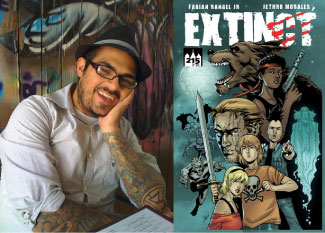The idea of “the evil twin” has become a pervasive cliche in our society. You’re confronted by a co-worker about an off-color comment made earlier in the day, and you blame your evil twin. Yuk-yuk-yuk. Everybody laughs and you get away with whatever unsavory statement you made. Easy peasy. Everybody knows about evil twins.
The question is, do they know about “Evil Siamese Twins?” Two entities glued together by a mistake of genetic fate, and forced to share a common subversive language understood only on a subliminal level by themselves, and those as inwardly freakish as the Twins are outwardly. Yeah, maybe a doctor could separate them with a lengthy and dangerous surgery, but neither would be the same again as they share so many vital organs.
The thought that such a bizarre gestalt could live among us is sense defying and yet, one does – at least in a broad metaphorical sense: comic books and rock n’ roll are in fact evil siamese twins.
Don’t believe me? Don’t see the connection? Well read on about these modern crossover artists and we’ll see if I can’t make a true believer of you yet!
MIKE ALLRED: Creator of Red Rocket 7 and Madman. Big Papa of THE GEAR
Readers of his most famous creator-owned property, Madman know that reading a Mike Allred story is like the best kind of deja vu. You’re clearly being taken on the Allred express train to someplace new, but it all feels so comfortable and familiar. Kansas, hell, we’re not even in 2011 anymore, Toto! This feeling carries through to the work he does for major publishers like Marvel Comics (Most recently on Daredevil and Fantastic Four, but including a run on X-Men.) to his more personal projects like Red Rocket 7, a science fiction-themed history of rock n roll.
Red Rocket 7, in fact, sparked the genesis of his current band, The Gear.
“When I was writing the soundtrack album around 1996-1997 for RED ROCKET 7 and my micro-budget ASTROESQUE feature, it became easier for me to record all the instruments in my own studio than depend on other musicians to show up. In the process, my two sons got better and better musically and I started using them.
I essentially grew my own real-life Partridge Family; but imagine if Pink Floyd, Bowie, and The Brian Jonestown Massacre were all related.”
He’s not kidding about that Partridge family thing. The first two albums, Son of Red Rocket 7 and Left of Center of the Universe are available, were written, played, recorded, and mastered in true DIY fashion by Mike and his two sons, Han and Bond. The addition of Bond’s wife Nicole as a bass player took The Gear from the home studio to the live stage, with other family members added to the group as the mood strikes.
If the line between Mike’s musicianship and comic creation seem to quiver and disappear in a psychedelic blur, take solace in the fact that you’re not the only one who feels that way:
“It’s all very similar. Daydreaming, collaborating, meditating, expressing. It’s all storytelling, capturing a mood or action. I often confuse myself. Am I making music? Drawing a picture?”
BRIAN JOHN MITCHELL: Creator and publisher at Silber Media. Lead drone of Remora
It’s a shame that most folks in the DIY crowd generally doesn’t cotton to the formality of creating a resume, because Brian’s would read like a dream job candidate for anyone looking to hire a “craft projects” manager. He’s the czar of zines. The master of the mini-comic. The duke of drone records.
Brian has self-published over 60 mini-comics, each of which is about the size of a matchbook. The stories, about 40 pages each, range in subject from life in futuristic slave states with giant robots to drugged-out rockers trying to get by to collections of abstract paintings. Recently, with the help of Kickstarter, Brian has made the entire set available in a handcrafted wooden box set!
Brian’s main musical project since 1995 is Remora. He describes the music as “Post-Apocalyptic Pop” but accepts that with its minimalist song structure and repeated tones the music would fall in most in the drone music genre to those looking for an easy label.
The modernity of Brian’s music forms a striking contrast to the rustic feel of his mini-comics, but the connection between the two art forms is apparent content-wise. Science fiction and fantasy themes run through his work with the same frequency that they do his comics.
That said, I received a striking answer from Brian when I asked him to compare the two art forms:
“Well, what they both have in common is the early, “fun” initial creation process, followed by a lot of tedious work that people-not-doing-them think also must be fun.”
Between you and me, I think a guy who runs a record label with over 100 catalog entries, has put out his own zines for over 17 years and makes comic books that’ll fit in your wallet’s credit card slot secretly likes tedious!
JOE QUESADA: Chief Creative Officer at Marvel Comics. Chief indulger in Idle Chatter
Read aloud, Joe Quesada’s story sounds like the American dream with a heavy Queens accent. The son of an immigrant construction worker (Joe’s father was on the crew that put up Shea Stadium!), Joe worked his way through college, and through the ranks of the 90s independent comic boom into the big league with gigs at both Marvel Comics and DC comics. Those jobs were in turn parlayed into a run as Editor-in-Chief and now his current position as Chief Creative Officer at Marvel. What saw him through the lean collegiate days and long hungry indie press nights? You can bet that in least in part another American dream, starting a rock band with his buddies.
A buncha teenage kids inspired by the Beatles to start up a garage band, Joe’s band, Idle Chatter, have been playing together since he was 19. A great parallel to all the teenage kids ( Joe included) inspired by Marvel Comics teams to pick up a pencil and make a comic book! Joe goes as far as to tell me that Stan Lee and Jack Kirby (creators of the Fantastic Four, The Hulk and about a zillion other iconic comics) are in his mind are the equivalent of Lennon McCartney and their comic runs as significant as Sgt. Peppers, Revolver et. al..
The similarities in the art form don’t end there for Joe. He feels that his experience with music has taught him how to create comics. To Joe, a comic is a song. It has its own tempo, needs bridges and needs to build crescendo. Further, Joe believes that just like you can’t take a sub-par song and “fix it in the mix” with studio tricks and instrumental embellishment, a sub-par comic book story can’t be saved by flashy art or editorial gimmick.
Marvel has a great history of mixing pop music and records with its comics. In the 60s, the Fantastic Four met the Beatles and full Frank Zappa ads often graced the pages of Dr. Strange Comics. Marvel went as far as to release a record under the guise of the Merry Marvel Marching Society (M.M.M.S. for short!) which had a college football style fight song on one side and a truly weird spoken word trip through Marvel Bullpen on the flip, the latter feeling more like an audio historical archive of New York City accents than a narrative of any sort.
In the 70s, Marvel glammed out with Alice Cooper and infamously published the Kiss comic whose ink was supposedly laced with the bands blood. In the 80s I have a vivid memory of Spider-Man singing “Oliver’s Army” while under the nefarious Purple Man’s mental domination.
Aware of all of this history in 2006, Joe took the opportunity to show off his musical chops by creating a few Marvel and Comic book shop themed Christmas songs. Reflective of Joe’s Beatles, although possessing a rowdiness more akin to Cheap Trick, these witty ditties show that while star-studded motion pictures with face-melting 3D effects have become the normal mode of transmedia at the Big M, there’s still a little bit of campfire song mentality that has embraced so many fans over the years.

FABIAN RANGEL: Creator of Fall and Extinct. Guitarist straight from the Golden Age
Fabian Rangel Jr. is a young gun in the modern “Creator Owned” movement sweeping through the indie comics world in thanks in no small part to upstarts like Fabian’s publisher, 215ink. His work in comics is eclectic, from the sci-fi “Fall” with its Alien crash landing to the horror of his high school kids vs. werewolf yarn “Extinct” to the bizzare cockfighting turned fatal for bird handlers inspired “Revenge Rooster.” Fabian blazes his way through genres with the energy you’d expect from man inspired by the 80s hardcore tempo of Minor Threat.
Having been in several bands over the past decade, (outfits earnestly named After The Fall, Golden Age and most recently the Loyal Hearts.) Fabian brings an all too rare been-there-done-that quality to DIY comics. He’s dealt with record companies, he’s been on tour and most importantly has partaken in the collaborative process, which has lent him confidence when it comes to the biz of making funny books.
“Making a comic is a lot like starting a band,” he quipped.
In Fabian’s mind a singer is equivalent to a comic writer, guitar players to pencilers and inkers, a bassist is like a colorist and the drummer is the letterer. He sees no difference between soliciting a record company with a demo and sending a script to the publisher. Or for that matter, packing up the van to play an out of town gig or packing it up to hit a comic con.
CHARLES SOULE: Creator of 27 and Strange Attractors. The namesake of the Charles Soule Band.
As if designed to prove my point, the headline blurb on Charles Soule’s website declares “I write and I sing and I play.” Clearly, he’s left out “I read.” The continuity of Soule’s musical style and comic book story come together gracefully in a manner that only an avid fan of music folklore and urban myth could pull off. His graphic novel “27,” for instance, is centered on a young rock star discovering to his horror why young rock stars look ahead so eagerly to their 28th birthdays. Right, Mr. Jones? Ms. Joplin? Mr. Hendrix? You get the idea…
Musically speaking, Charles divides his attention between Elvis Costello and Ben Folds style pop-rock singer-song/writer material and his own brand of jazz that focuses on stripping down and laying out unlikely source material, such as Stevie Wonder, The Cure and even the terminator’s movie theme music.
While Charles integrates the subject matter of music seamlessly into his comics, he does see many sharp contrasts between the two art forms when it comes to the creative process. Charles feels confident that as a musician, he can tackle songwriter in a top to bottom fashion, while comic books are inherently a collaborative effort. He simply can’t produce without an artist attached. It’s a situation that Charles seems to find humbling to a degree.
“ When I get an email with some new layouts or finished pages, I always take a deep breath, because it’s like jumping off a cliff. It goes from something I did to something we did, and it can be intense.”
JEFF SUTER: Senior Art Director at Marvel Comics. Sgt. At Arms for Hardcover!
Another M.M.M.S. (Mighty Marvel Muckety-Muck Split-Personality), Jeff Suter is Marvel’s Senior Art Director by day and the lead singer and guitarist for rock music chameleon Hardcover by night.
Hardcover, as you might guess from the name, makes its bones by playing cover material from a catalog that includes everything from the classics of bubble-glam rock like AC/DC and Ozzy to modern buzz rock radio pleasers by Pearl Jam and Blink 182. His treatment of these songs mirrors his treatment of the classic Marvel characters in his capacity as Art Director. Jeff takes great pains to respect his source material regardless of whether it’s a song or a comic character, realizing that the fans that he plays to are coming for a nostalgic blast.
“When we do a Rush song, it better sound like Rush. That is something I take very seriously. Just as a writer will have his own take on Captain America, that writer is not going to redefine the character. He can’t rewrite Steve Rogers history and I feel the same about covering music.”
And More:
The fine artists above are just a sample of the crossover. I’d be remiss if I didn’t at least name drop my frequent Nix Comics collaborators Bob Ray Starker and Matt Wyatt. Bob in particular cemented the idea into my head that a guy with a guitar and an amp is pretty much the same type of nerd as a guy with a pencil and pad. For that matter, the caveman banging a couple of rocks together in rhythm at the campfire was probably the same guy going into the cave and painting the story of the last hunt on the cave wall. I’m tellin’ ya, the two things are inseparable.





Pingback: End of the Road, Interview, & Last Night’s Dream | Silber Blog()